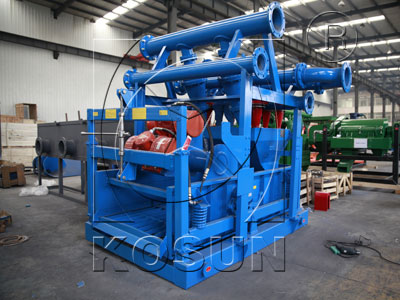The technical Features of Kosun desander
2013-08-27
KOSUN desander is used as the 2nd stage of solids control for drilling mud, which makes separations between 40 and 100 microns. A desander is an important part of the mining and drilling process. This simple container helps filter out grainy solids from drilling liquid, often in mud form, that is brought up from a drilling hole. Located close to the end of the entire purification process, but not the last step, desanding is renowned for its simplicity and lack of moving parts. Its effectiveness has seen this technique adapted into many industries.
The technical Features of Kosun desander:
1. 100% Polyurethane(PU) Material for desander cones with longer using life
2. Clamp type for easy maintenance.
3. Compact design with small footprint.
4. Flexible options for 1 or 2,or 3 for different capacities.
5. Flexible fast connection are available for user assembly.

Many times when drilling and mining occurs, drilling fluids are required to aid in the process of finding the underground target. For example, when drilling for natural gas pockets, a drill bit can easily get hot and melt or break from stress. When a drilling fluid is added to the hole, it helps cool the bit and keep it together, saving the drilling team a large amount of time. Recovering the drilling fluid is a multi-step process of purification, and the desander is a small part of this.
The steps before a desander is used are numerous and differ depending on the industry that is utilizing the drilling fluid recovery. Generally, colorfully named tools such as gas busters, gumbo removal equipment, shale shakers, mud cleaners and vacuum degassers are all used to break down the fluid to the stage where the desander can remove small grains. After the desander is utilized, many industries also use a desilter to further purify the liquid.
When drilling fluid reaches desanders, it enters through a pressurized tube and first meets the desander cone. This conical shape spins the fluid in a way that is similar the way water flows in a draining sink, except that the walls of desander cones are porous and allow sand grains to be filtered out. There are no moving parts of a desander, and the removal of grains is done exclusively by gravity and pressure. A desander generally is not a large tool; on smaller operations, it can be about the size of a bathtub, and it rarely gets larger than an average automobile. When the fluid reaches the small end of the cone, it is forced out a tube and on to the next step of the purification process.
This type of work generally is utilized by the petroleum industry. Other industries also use desanders, mostly those dealing with drilling and mining for substances such as natural gas. Companies that manage lakes and dams sometimes use desilters and desanders to pass along water and keep it free of impurities.
News
- 07-11Technical features of using KOSUN drilling waste mud treatment system
- 07-07Main equipment of solids control system in drilling
- 06-26Geothermal well mud treatment system manufacturer—KOSUN solid control
- 06-26The key to achieving mud zero discharge is on-site processing after solid-liquid separation
- 05-10Application Scenarios of KOSUN Drilling Waste Treatment Equipment
- 05-10Environmental protection new regulations require to achieve zero discharge of drilling waste
- 05-09KOSUN Solid-liquid Separation Equipment is used in the construction industry
- 04-19What are the main functions of the Mud Agitator during use?
- 04-15The Advantages of KOSUN's trenchless horizontal directional crossing mud recovery system
- 03-15Vacuum degasser is mainly divided into centrifugal degasser and jet degasser




